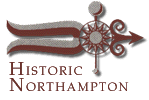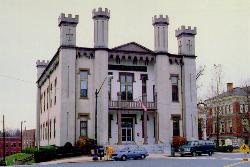
Bridge Street Cemetery Northampton Architecture Historic Markers 
|


Northampton Architecture- Quadrant 3

Northampton City Hall
Northampton's City Hall, built in 1850, has survived despite numerous assaults on its very existence. William Fenno Pratt, who designed many buildings on Main Street, conceived of it as a novelty. It combines elements of the then "new" revival styles of Gothic, Tudor and the trademark Norman towers replete with arrow slits. Being a novelty it was bound to attract both ardent admirers as well as detractors. One of the most powerful detractors was Mayor Harry E. Bicknell, who dubbed it a building with "flip-flops and flop-doodles." He, along with many others in 1923, wanted it torn down and replaced. Although aesthetic debate raged it was the fiscally conservative voters of Northampton who saved the building, opting to remodel it in order to save money. Bicknell had the last word, though, and refused to replace the wood crenellations on the towers that had rotted away in the early 1900s. That restoration was finally done in 1985 and again in 1993, through volunteer labor and donations.
One of the charms City Hall lost in the 1923 restoration was its second floor auditorium, which took up most of the square footage of the top floor. The auditorium, magnificently high ceilinged with a rosette and chandelier in the center, had hosted a prestigious array of singers (Jenny Lind), self-promoters (P.T. Barnum, Horace Greeley), lawmakers (William Lloyd Garrison, Oliver Wendell Holmes), honored writers (Henry Ward Beecher, Ralph Waldo Emerson) and illustrious abolitionists (Sojourner Truth, Frederick Douglass). The room held more than a thousand people and was well used, sometimes filling to standing room only. Although that space is lost, the oddly grand focal point of Main Street has been retained thanks to the tenacity of a few residents who fought to preserve novelty over practicality.

Contents Copyright 2025. Historic Northampton.